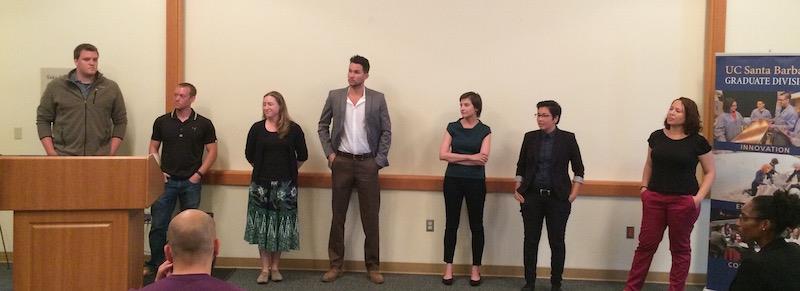Top Stories
Find out who the winners are from Preliminary Rounds 5 and 6 of the 2016 Grad Slam!
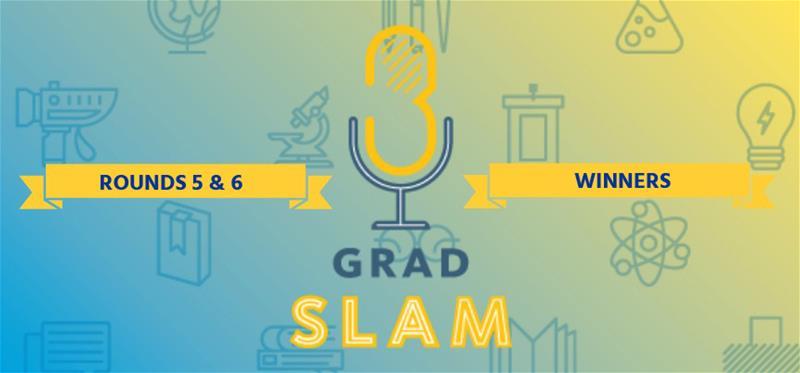
Never a dull moment with Grad Slam! Yesterday saw the crowning of not six but seven winners who each received a $50 UCSB Bookstore gift card and secured their spot in the semifinal rounds. Due to a tie among the judges, four winners advanced from Round 5. Read on to find out more!
And the winners are...
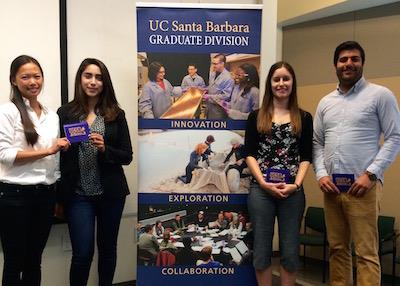
Round 5
Rohan Bhandari
Isabel Ochoa
Kendall Mills
Nicole Leung, People's Choice
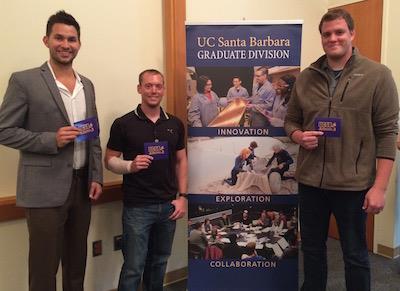
Round 6
Phillip Rogers
Chad Spensky
Abel Gustafson, People's Choice
View photos and read synopses of all the talks from Rounds 5 and 6 below. You âmay find the full Grad Slam competition schedule here.
Round 5
Wednesday, April 6 | 11 a.m. to noon
Engineering Science Building 1001
Dana Bardolph | Anthropology
Why Archaeology (Still) Needs Feminism
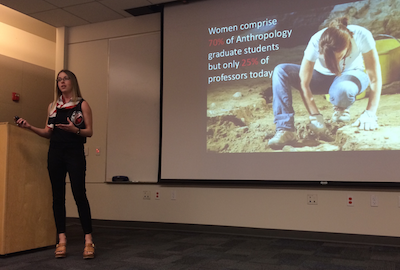 While it is widely known that men dominate boardrooms, newsrooms, and political offices, it is arguably less obvious that they also dominate scholarly publishing records. Women's presence in higher education, including Ph.D. programs, has increased dramatically in recent decades, but as authors of scholarly papers - keys to career success - their publishing patterns differ from those of men. I examine this issue in the field of archaeology, revealing that despite a current culture and context of women's advancement in academic archaeology, many challenges and obstacles remain.
While it is widely known that men dominate boardrooms, newsrooms, and political offices, it is arguably less obvious that they also dominate scholarly publishing records. Women's presence in higher education, including Ph.D. programs, has increased dramatically in recent decades, but as authors of scholarly papers - keys to career success - their publishing patterns differ from those of men. I examine this issue in the field of archaeology, revealing that despite a current culture and context of women's advancement in academic archaeology, many challenges and obstacles remain.
Rohan Bhandari | Physics
Searching for the Universe: Particle Physics in One Sentence
Dark matter makes up 80% of the mass in the universe, and we know nothing about it. In fact, the "dark" in dark matter refers not to light, but rather our ignorance. However, by colliding protons together near the speed of light, it may be possible to not only understand the properties of dark matter, but open new portals for physicists to study the universe.
Ying-Jung Chen | Geography
Do We Have Enough Water Resources? A View from Storage-Discharge Relations among Local Watersheds
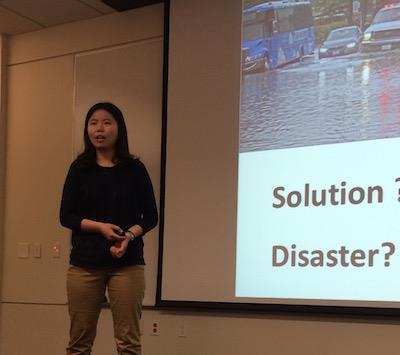 Examining the role of antecedent moisture based upon storage-discharge models from catchment perspectives can help us understand the characteristics and drivers of droughts and floods.This research also serves to elucidate the trends that take into account catchment input (climate variability), catchment characteristics (land use/land cover, topography and geologic), and storage and hydrologic transferring process interactions. Since the trends of antecedent moisture are rarely captured, this research will contribute to refine our understanding of the generation of extreme hydroclimate events within watershed hydrologic systems and play an important role in shaping better strategies for water resource management and natural disaster risk reduction in the future.
Examining the role of antecedent moisture based upon storage-discharge models from catchment perspectives can help us understand the characteristics and drivers of droughts and floods.This research also serves to elucidate the trends that take into account catchment input (climate variability), catchment characteristics (land use/land cover, topography and geologic), and storage and hydrologic transferring process interactions. Since the trends of antecedent moisture are rarely captured, this research will contribute to refine our understanding of the generation of extreme hydroclimate events within watershed hydrologic systems and play an important role in shaping better strategies for water resource management and natural disaster risk reduction in the future.
Laura Hooton | History
Co-Opting the Border: An African American Agricultural Colony in Baja California
Little Liberia, an African American agricultural colony in Baja California, Mexico, was established in 1917 by elite members of the Los Angeles Black community. The colony later attracted Blacks from throughout the United States and Canada, and its goal was to change social and economic racial injustices in the United States by becoming a food source for California while physically living in Mexico. This community is unique, but it also shows us an alternate perspective to border crossing and cross-racial cooperation.
Shabnam Larimian | Electrical & Computer Engineering
VeSFET: The New Approach to Mitigate Current Electronic Circuits' Problems
Conventional transistors that are used in electronic devices need improvement. VeSFET is a new transistor that can be a replacement for the conventional transistors to mitigate the current problems.
Nicole Leung | Biomolecular Science & Engineering
Lighting the Path from the Eye to the Brain
Our eyes serve two functions: to see and to reset our biological clocks. I will share some insight into how light is received by our eyes and more importantly, how light information is converted into a language that our brains can understand. I will discuss my work in the Craig Montell lab, using the fruit fly as a model organism to study the path of light from the eye to the brain. I will highlight the importance of basic research and the use of model organisms to advance knowledge about humans.
Kendall Mills | Bren School of Environmental Science & Management
The Market Value of Non-Market Goods: Conservation of Endangered Whale Species in the Santa Barbara Channel
This is a component of a larger Group Project tasked with identifying sustainable funding sources for a whale conservation program in the Santa Barbara Channel. Blue, fin, and humpback whales are subject to lethal collisions with large container ships that transit the channel, and NOAA has attempted for over a decade to impose a vessel speed reduction (VSR) program in the channel to reduce the occurrence of deadly whale strikes. These attempts have been unsuccessful largely because the shipping industry can clearly demonstrate the costs they would have to shoulder as a result of speed restrictions, whereas the value of avoided whale deaths is unknown and difficult to define. This project component elicited consumer willingness to pay for whale conservation on the West Coast, and in doing so provided an estimate of the market value of living whales, for which there is currently no market at all.
Isabel Ochoa | Global Studies
A Failed Mexican State? Challenging the Oversimplified Narrative of Mexico's Drug War
The general understanding of Mexico's drug war has tended toward simplistic - both in our image of kingpins as antiheroes and our assumption that the states in which these exist are failed states. Through the cartels' use of violence and the use of violence by the Autodefensas born to fight the cartels, the Mexican state's monopoly of violence is put into question. Although this monopoly of violence is an incredibly important factor of any state, its central use in labeling Mexico as a failed state may not be fair or useful.
Yan Shoshitaishvili | Computer Science
Hacked by a Robot or Steal This Movie: Breaking Copy Protection in Netflix and Friends
The current world is so interconnected that cyber security is paramount. Like Chess and Go, the art of computer hacking has, until now, been ruled by humans. DARPA is trying to change this with the Cyber Grand Challenge, a contest to develop an autonomous hacking system. I will talk about the need for automated hacking systems and UCSB's entry into the competition, which is currently one of the 7 finalist hacking robots!
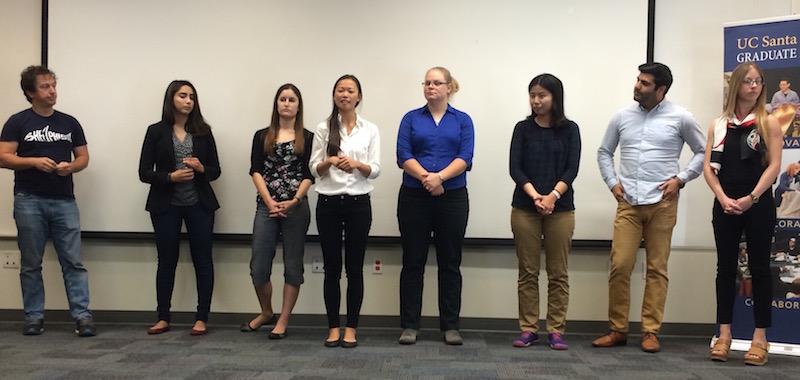
Round 6
Wednesday April 6 | 3 to 4 p.m.
McCune Conference Room, HSSB 6020
Abel Gustafson | Communication
Good Intentions, Bad Effects: Cumulative Advantage in Science Communication
The communication of science to the public seeks to change knowledge, attitudes, and behaviors. However, these efforts often produce unintended, detrimental effects of cumulative advantage - where those who are in greatest need of knowledge, attitude, and behavior change are also those who benefit the least from the communication of the relevant information. In this talk, I describe this phenomenon and discuss possible ways to mitigate its harmful social effects.
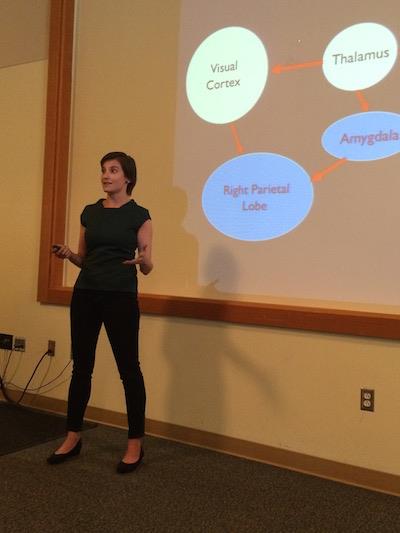 Amanda Kaczmarek | Psychological & Brain Sciences
Amanda Kaczmarek | Psychological & Brain Sciences
Moral Decision Making and the Magnocellular Pathway
The right temporoparietal junction (rTPJ) has been shown to activate preferentially when subjects make a Deontological moral judgment, but not a Utilitarian judgment. The rTPJ plays a role in theory of mind and empathy - which seem reasonably related to moral tasks - and with processing low spatial frequency (LSF) visual information, a seemingly unrelated task. LSF signals travel from the retinas to the rTPJ by way of the magnocellular pathway, and my hypothesis is that the magnocellular pathway is also carrying along at least some of the signals used by the rTPJ for morality-relevant tasks and judgments. Thus, if I am able to temporarily block signal transmission of the magnocellular pathway - by having subjects gaze at a visual pattern - I may be able to make their judgments in moral dilemmas skew more Utilitarian.
Emmie Matsuno | Counseling, Clinical, & School Psychology
LGB and T? Examining LGB Attitudes Towards Transgender Populations
This presentation will discuss the results of a study that examined attitudes of cisgender LGB people towards transgender people. This study was the first to measure attitudes towards 5 different sub populations within the trans community (e.g. trans women, genderqueer). Key findings and implications for research and practice will be addressed.
Amanda Pinheiro de Oliveira | Global Studies
How Zika Has âWon Brazil
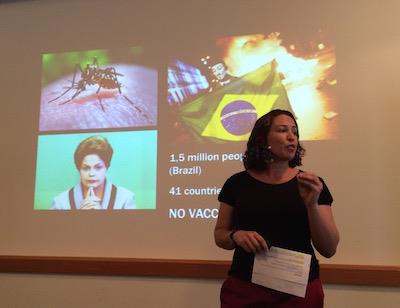 Despite the global concern about the spread of the Zika virus, initially transmitted by a mosquito in tropical countries but not associated to STDs and microcephaly in babies, Brazil - the epicenter of the outbreak - has benefitted from it. The Zika virus has shifted the focus away from the political and economic crisis that the country, its president, and the party in charge currently undergo, mainly because the state's response was the deployment of military forces to "fight the mosquito." This is a strategy to practice "domestic militarized humanitarian intervention" that might not be successful in avoiding the spread of the virus, especially because the country will host the 2016 Olympics in August, when 6,177 athletes from 206 countries will be exposed to the virus and possibly will carry Zika out when they return to their countries.
Despite the global concern about the spread of the Zika virus, initially transmitted by a mosquito in tropical countries but not associated to STDs and microcephaly in babies, Brazil - the epicenter of the outbreak - has benefitted from it. The Zika virus has shifted the focus away from the political and economic crisis that the country, its president, and the party in charge currently undergo, mainly because the state's response was the deployment of military forces to "fight the mosquito." This is a strategy to practice "domestic militarized humanitarian intervention" that might not be successful in avoiding the spread of the virus, especially because the country will host the 2016 Olympics in August, when 6,177 athletes from 206 countries will be exposed to the virus and possibly will carry Zika out when they return to their countries.
Barbara Quimby | Geography
Tradition, Equity, and Conservation: Coastal Comanagement in Samoa
For island communities, the sustainability of coastal environments is a human rights issue. The management of beaches, reefs, and lagoons is intimately tied to issues of local food security, gender parity, and cultural identity. In Samoa, where 40% of residents rely on local small-scale fishing for subsistence, two community-based management programs are focused on protecting inshore fisheries and coastal environments: one working within the traditional village leadership systems, and one relying on international partnerships. This research examines the relationship of the different scales and institutions of these programs to local subsistence, social equity, and environmental outcomes for Samoan communities.
Phillip Rogers | Linguistics
Featuring the Bituri: Linguistic Fieldwork in Papua New Guinea
My research combines linguistic fieldwork with the study of linguistic theory as applicable to all languages. I will share research anecdotes from my work on the Bitur language of Papua New Guinea that shed light on the fundamental questions of linguistic typology: what languages can be, what they cannot be, and why. But more importantly, I will discuss how linguistic fieldwork is about giving a voice to the marginalized speakers of endangered and undocumented languages.
Chad Spensky | Computer Science
Single Device Authentication
Single Device Authentication (SDA) attempts to alleviate "all" of the burden involved with authentication. SDA leverages secure hardware in smartphones to provide users with significantly more security and a more usable experience. Furthermore, we show that this system can be leveraged to supplant all existing schemes (e.g., passwords, keys, automobiles).
